Business Decision Making: NPV and Payback Period for Investment
VerifiedAdded on 2023/06/17
|7
|1313
|470
Report
AI Summary
This report provides a comprehensive analysis of business decision-making using the payback period and net present value (NPV) methods. It evaluates two potential investment projects for AJ plc, a chocolate manufacturing company: a vegan chocolate project (Project A) and a vegan spread project (...

BUSINESS DECISION
MAKING
MAKING
Paraphrase This Document
Need a fresh take? Get an instant paraphrase of this document with our AI Paraphraser
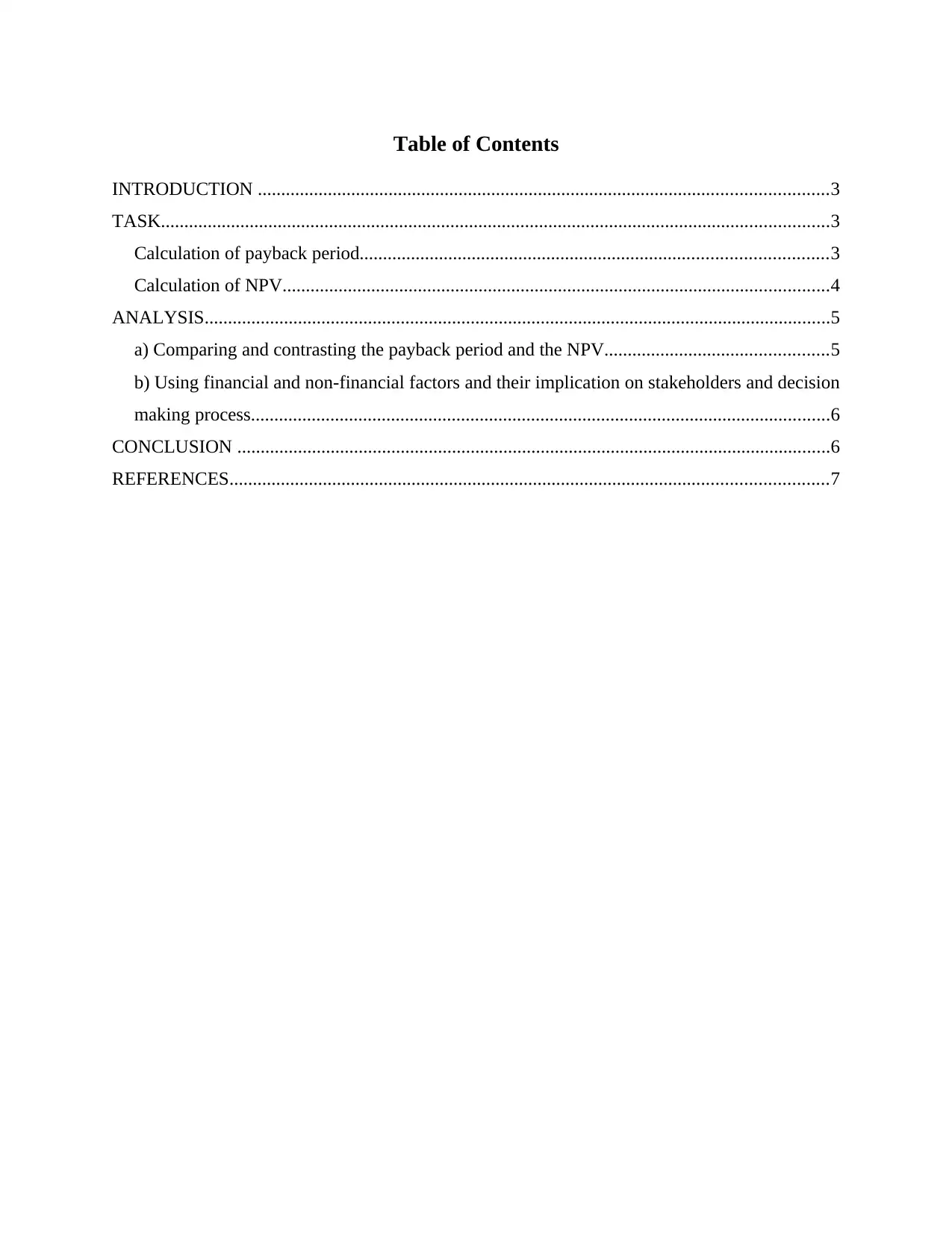
Table of Contents
INTRODUCTION ..........................................................................................................................3
TASK...............................................................................................................................................3
Calculation of payback period....................................................................................................3
Calculation of NPV.....................................................................................................................4
ANALYSIS......................................................................................................................................5
a) Comparing and contrasting the payback period and the NPV................................................5
b) Using financial and non-financial factors and their implication on stakeholders and decision
making process............................................................................................................................6
CONCLUSION ...............................................................................................................................6
REFERENCES................................................................................................................................7
INTRODUCTION ..........................................................................................................................3
TASK...............................................................................................................................................3
Calculation of payback period....................................................................................................3
Calculation of NPV.....................................................................................................................4
ANALYSIS......................................................................................................................................5
a) Comparing and contrasting the payback period and the NPV................................................5
b) Using financial and non-financial factors and their implication on stakeholders and decision
making process............................................................................................................................6
CONCLUSION ...............................................................................................................................6
REFERENCES................................................................................................................................7
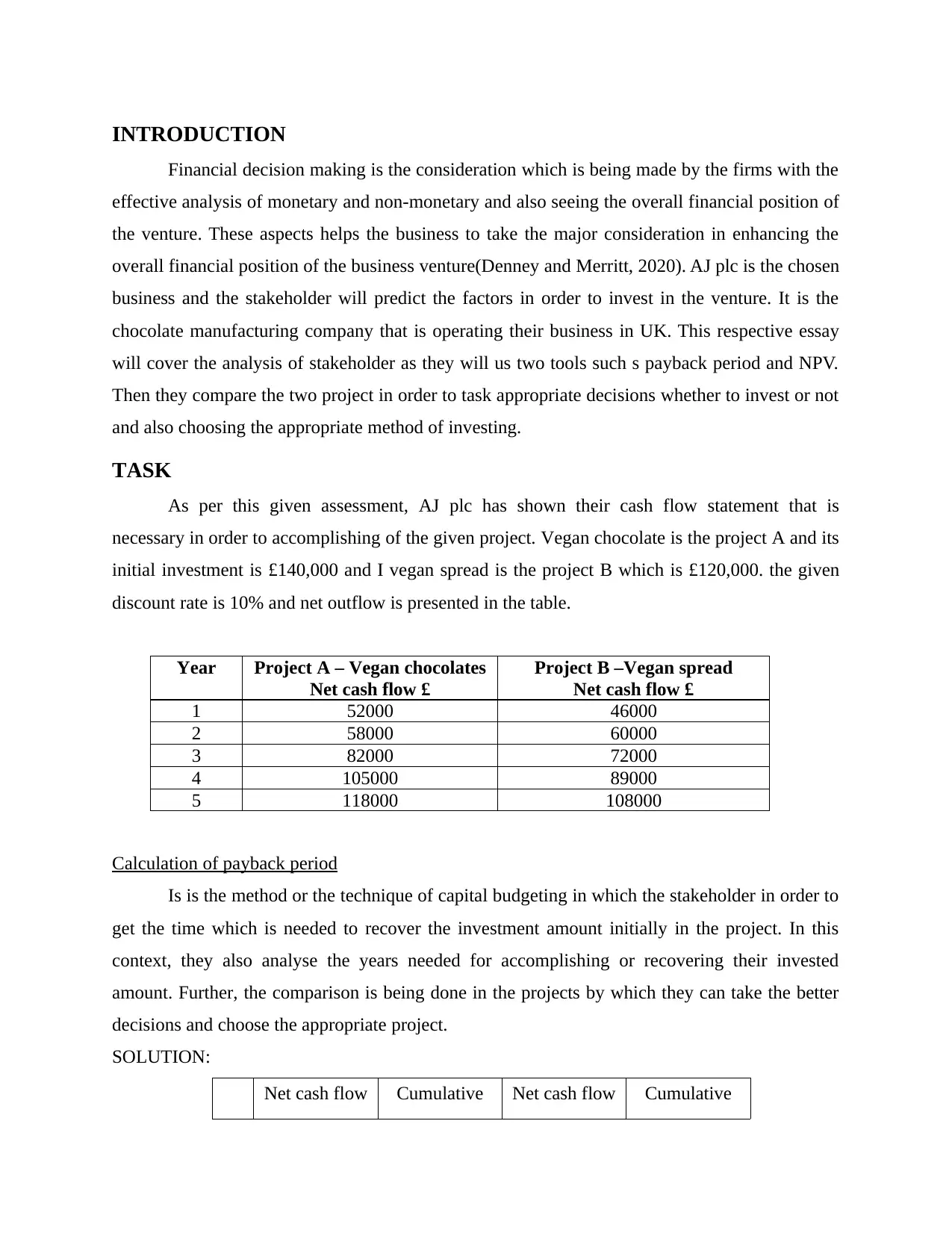
INTRODUCTION
Financial decision making is the consideration which is being made by the firms with the
effective analysis of monetary and non-monetary and also seeing the overall financial position of
the venture. These aspects helps the business to take the major consideration in enhancing the
overall financial position of the business venture(Denney and Merritt, 2020). AJ plc is the chosen
business and the stakeholder will predict the factors in order to invest in the venture. It is the
chocolate manufacturing company that is operating their business in UK. This respective essay
will cover the analysis of stakeholder as they will us two tools such s payback period and NPV.
Then they compare the two project in order to task appropriate decisions whether to invest or not
and also choosing the appropriate method of investing.
TASK
As per this given assessment, AJ plc has shown their cash flow statement that is
necessary in order to accomplishing of the given project. Vegan chocolate is the project A and its
initial investment is £140,000 and I vegan spread is the project B which is £120,000. the given
discount rate is 10% and net outflow is presented in the table.
Year Project A – Vegan chocolates
Net cash flow £
Project B –Vegan spread
Net cash flow £
1 52000 46000
2 58000 60000
3 82000 72000
4 105000 89000
5 118000 108000
Calculation of payback period
Is is the method or the technique of capital budgeting in which the stakeholder in order to
get the time which is needed to recover the investment amount initially in the project. In this
context, they also analyse the years needed for accomplishing or recovering their invested
amount. Further, the comparison is being done in the projects by which they can take the better
decisions and choose the appropriate project.
SOLUTION:
Net cash flow Cumulative Net cash flow Cumulative
Financial decision making is the consideration which is being made by the firms with the
effective analysis of monetary and non-monetary and also seeing the overall financial position of
the venture. These aspects helps the business to take the major consideration in enhancing the
overall financial position of the business venture(Denney and Merritt, 2020). AJ plc is the chosen
business and the stakeholder will predict the factors in order to invest in the venture. It is the
chocolate manufacturing company that is operating their business in UK. This respective essay
will cover the analysis of stakeholder as they will us two tools such s payback period and NPV.
Then they compare the two project in order to task appropriate decisions whether to invest or not
and also choosing the appropriate method of investing.
TASK
As per this given assessment, AJ plc has shown their cash flow statement that is
necessary in order to accomplishing of the given project. Vegan chocolate is the project A and its
initial investment is £140,000 and I vegan spread is the project B which is £120,000. the given
discount rate is 10% and net outflow is presented in the table.
Year Project A – Vegan chocolates
Net cash flow £
Project B –Vegan spread
Net cash flow £
1 52000 46000
2 58000 60000
3 82000 72000
4 105000 89000
5 118000 108000
Calculation of payback period
Is is the method or the technique of capital budgeting in which the stakeholder in order to
get the time which is needed to recover the investment amount initially in the project. In this
context, they also analyse the years needed for accomplishing or recovering their invested
amount. Further, the comparison is being done in the projects by which they can take the better
decisions and choose the appropriate project.
SOLUTION:
Net cash flow Cumulative Net cash flow Cumulative
⊘ This is a preview!⊘
Do you want full access?
Subscribe today to unlock all pages.

Trusted by 1+ million students worldwide
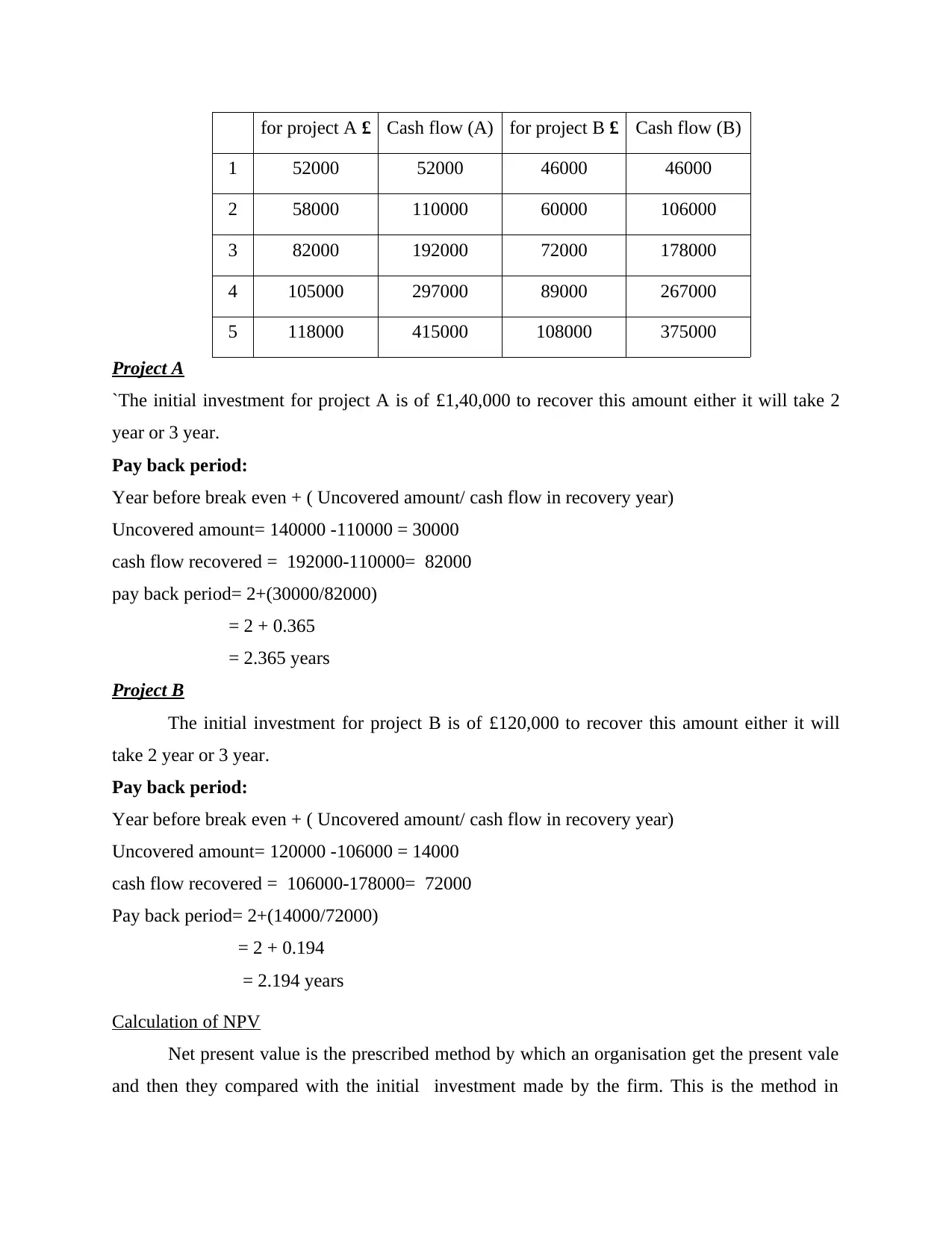
for project A £ Cash flow (A) for project B £ Cash flow (B)
1 52000 52000 46000 46000
2 58000 110000 60000 106000
3 82000 192000 72000 178000
4 105000 297000 89000 267000
5 118000 415000 108000 375000
Project A
`The initial investment for project A is of £1,40,000 to recover this amount either it will take 2
year or 3 year.
Pay back period:
Year before break even + ( Uncovered amount/ cash flow in recovery year)
Uncovered amount= 140000 -110000 = 30000
cash flow recovered = 192000-110000= 82000
pay back period= 2+(30000/82000)
= 2 + 0.365
= 2.365 years
Project B
The initial investment for project B is of £120,000 to recover this amount either it will
take 2 year or 3 year.
Pay back period:
Year before break even + ( Uncovered amount/ cash flow in recovery year)
Uncovered amount= 120000 -106000 = 14000
cash flow recovered = 106000-178000= 72000
Pay back period= 2+(14000/72000)
= 2 + 0.194
= 2.194 years
Calculation of NPV
Net present value is the prescribed method by which an organisation get the present vale
and then they compared with the initial investment made by the firm. This is the method in
1 52000 52000 46000 46000
2 58000 110000 60000 106000
3 82000 192000 72000 178000
4 105000 297000 89000 267000
5 118000 415000 108000 375000
Project A
`The initial investment for project A is of £1,40,000 to recover this amount either it will take 2
year or 3 year.
Pay back period:
Year before break even + ( Uncovered amount/ cash flow in recovery year)
Uncovered amount= 140000 -110000 = 30000
cash flow recovered = 192000-110000= 82000
pay back period= 2+(30000/82000)
= 2 + 0.365
= 2.365 years
Project B
The initial investment for project B is of £120,000 to recover this amount either it will
take 2 year or 3 year.
Pay back period:
Year before break even + ( Uncovered amount/ cash flow in recovery year)
Uncovered amount= 120000 -106000 = 14000
cash flow recovered = 106000-178000= 72000
Pay back period= 2+(14000/72000)
= 2 + 0.194
= 2.194 years
Calculation of NPV
Net present value is the prescribed method by which an organisation get the present vale
and then they compared with the initial investment made by the firm. This is the method in
Paraphrase This Document
Need a fresh take? Get an instant paraphrase of this document with our AI Paraphraser
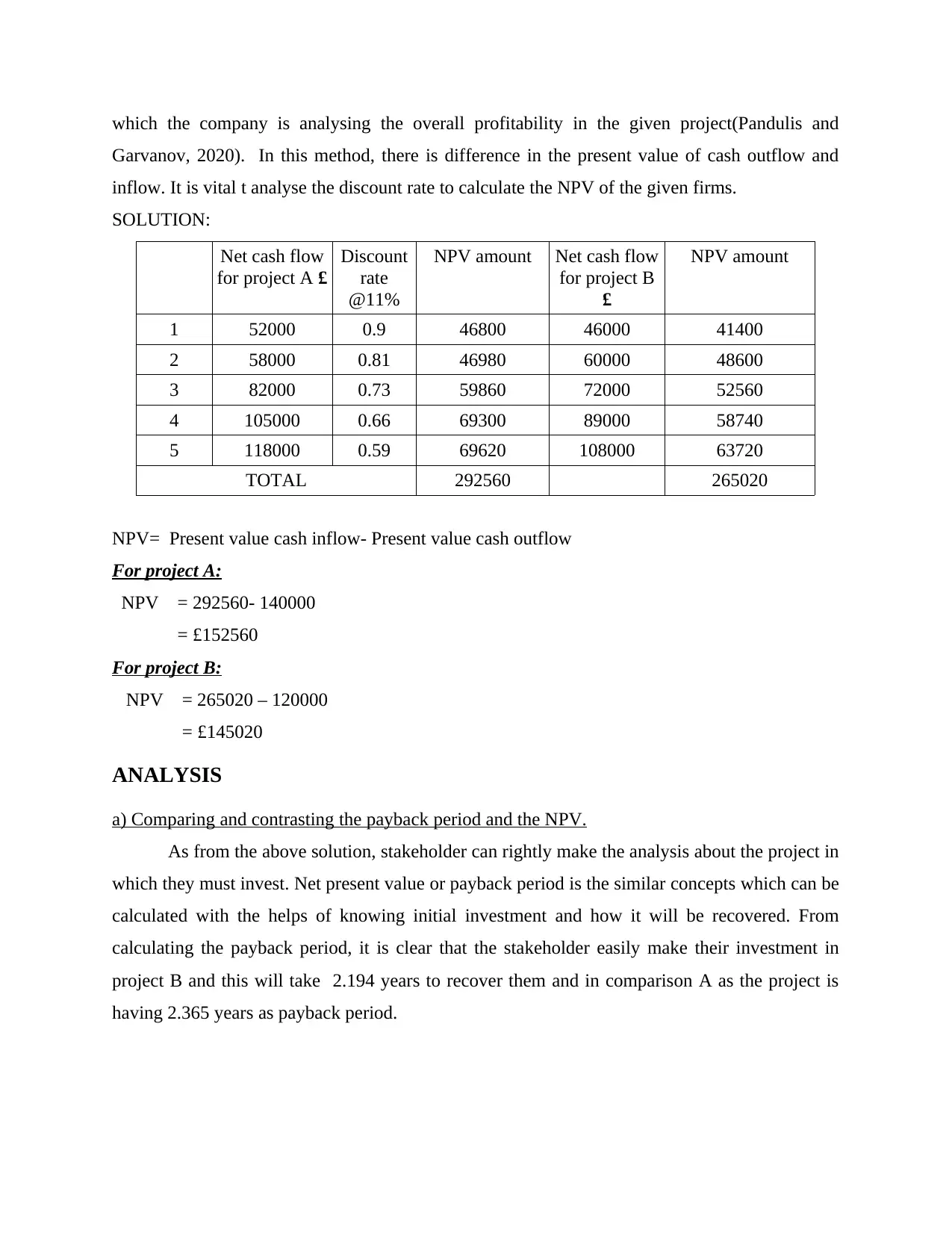
which the company is analysing the overall profitability in the given project(Pandulis and
Garvanov, 2020). In this method, there is difference in the present value of cash outflow and
inflow. It is vital t analyse the discount rate to calculate the NPV of the given firms.
SOLUTION:
Net cash flow
for project A £
Discount
rate
@11%
NPV amount Net cash flow
for project B
£
NPV amount
1 52000 0.9 46800 46000 41400
2 58000 0.81 46980 60000 48600
3 82000 0.73 59860 72000 52560
4 105000 0.66 69300 89000 58740
5 118000 0.59 69620 108000 63720
TOTAL 292560 265020
NPV= Present value cash inflow- Present value cash outflow
For project A:
NPV = 292560- 140000
= £152560
For project B:
NPV = 265020 – 120000
= £145020
ANALYSIS
a) Comparing and contrasting the payback period and the NPV.
As from the above solution, stakeholder can rightly make the analysis about the project in
which they must invest. Net present value or payback period is the similar concepts which can be
calculated with the helps of knowing initial investment and how it will be recovered. From
calculating the payback period, it is clear that the stakeholder easily make their investment in
project B and this will take 2.194 years to recover them and in comparison A as the project is
having 2.365 years as payback period.
Garvanov, 2020). In this method, there is difference in the present value of cash outflow and
inflow. It is vital t analyse the discount rate to calculate the NPV of the given firms.
SOLUTION:
Net cash flow
for project A £
Discount
rate
@11%
NPV amount Net cash flow
for project B
£
NPV amount
1 52000 0.9 46800 46000 41400
2 58000 0.81 46980 60000 48600
3 82000 0.73 59860 72000 52560
4 105000 0.66 69300 89000 58740
5 118000 0.59 69620 108000 63720
TOTAL 292560 265020
NPV= Present value cash inflow- Present value cash outflow
For project A:
NPV = 292560- 140000
= £152560
For project B:
NPV = 265020 – 120000
= £145020
ANALYSIS
a) Comparing and contrasting the payback period and the NPV.
As from the above solution, stakeholder can rightly make the analysis about the project in
which they must invest. Net present value or payback period is the similar concepts which can be
calculated with the helps of knowing initial investment and how it will be recovered. From
calculating the payback period, it is clear that the stakeholder easily make their investment in
project B and this will take 2.194 years to recover them and in comparison A as the project is
having 2.365 years as payback period.
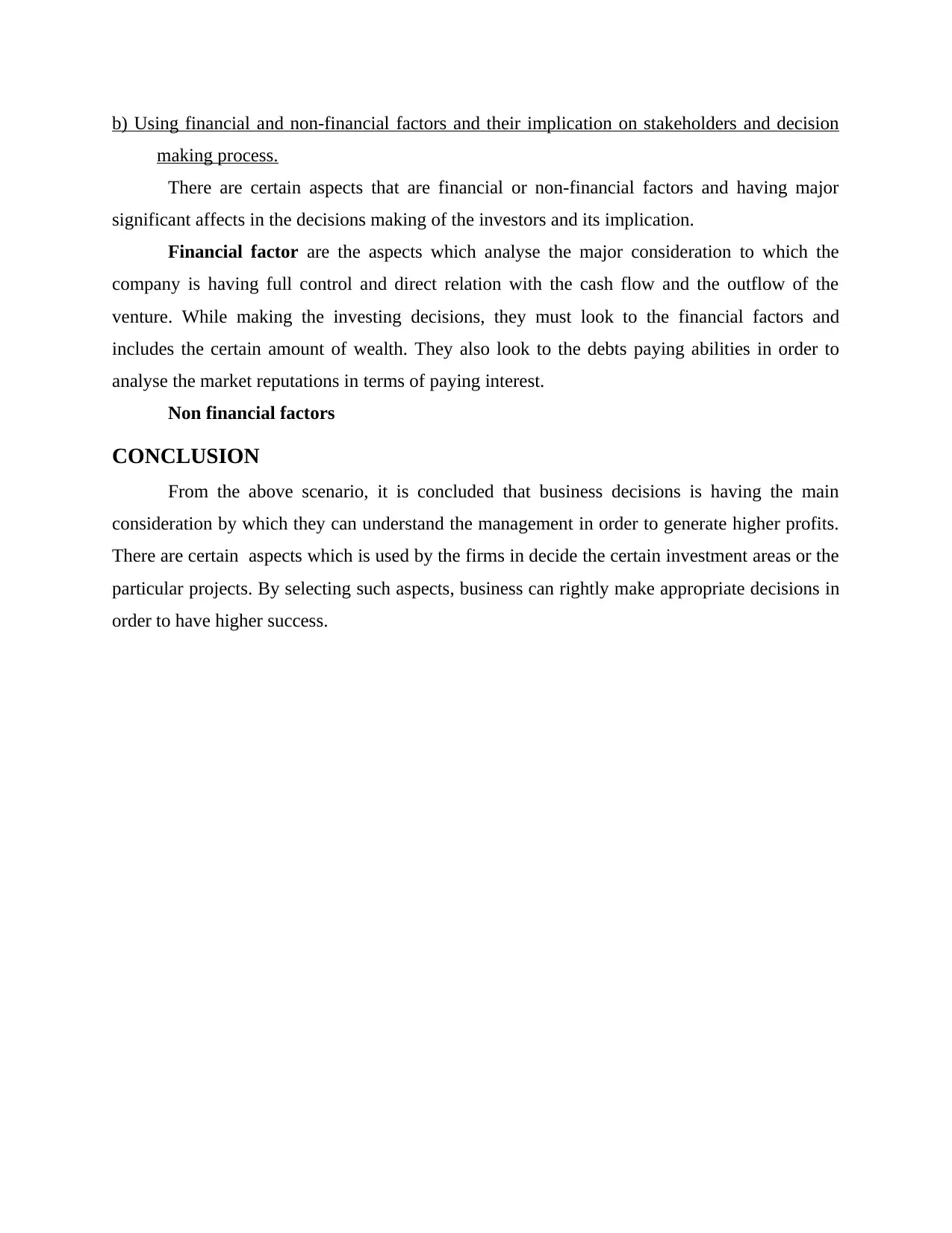
b) Using financial and non-financial factors and their implication on stakeholders and decision
making process.
There are certain aspects that are financial or non-financial factors and having major
significant affects in the decisions making of the investors and its implication.
Financial factor are the aspects which analyse the major consideration to which the
company is having full control and direct relation with the cash flow and the outflow of the
venture. While making the investing decisions, they must look to the financial factors and
includes the certain amount of wealth. They also look to the debts paying abilities in order to
analyse the market reputations in terms of paying interest.
Non financial factors
CONCLUSION
From the above scenario, it is concluded that business decisions is having the main
consideration by which they can understand the management in order to generate higher profits.
There are certain aspects which is used by the firms in decide the certain investment areas or the
particular projects. By selecting such aspects, business can rightly make appropriate decisions in
order to have higher success.
making process.
There are certain aspects that are financial or non-financial factors and having major
significant affects in the decisions making of the investors and its implication.
Financial factor are the aspects which analyse the major consideration to which the
company is having full control and direct relation with the cash flow and the outflow of the
venture. While making the investing decisions, they must look to the financial factors and
includes the certain amount of wealth. They also look to the debts paying abilities in order to
analyse the market reputations in terms of paying interest.
Non financial factors
CONCLUSION
From the above scenario, it is concluded that business decisions is having the main
consideration by which they can understand the management in order to generate higher profits.
There are certain aspects which is used by the firms in decide the certain investment areas or the
particular projects. By selecting such aspects, business can rightly make appropriate decisions in
order to have higher success.
⊘ This is a preview!⊘
Do you want full access?
Subscribe today to unlock all pages.

Trusted by 1+ million students worldwide
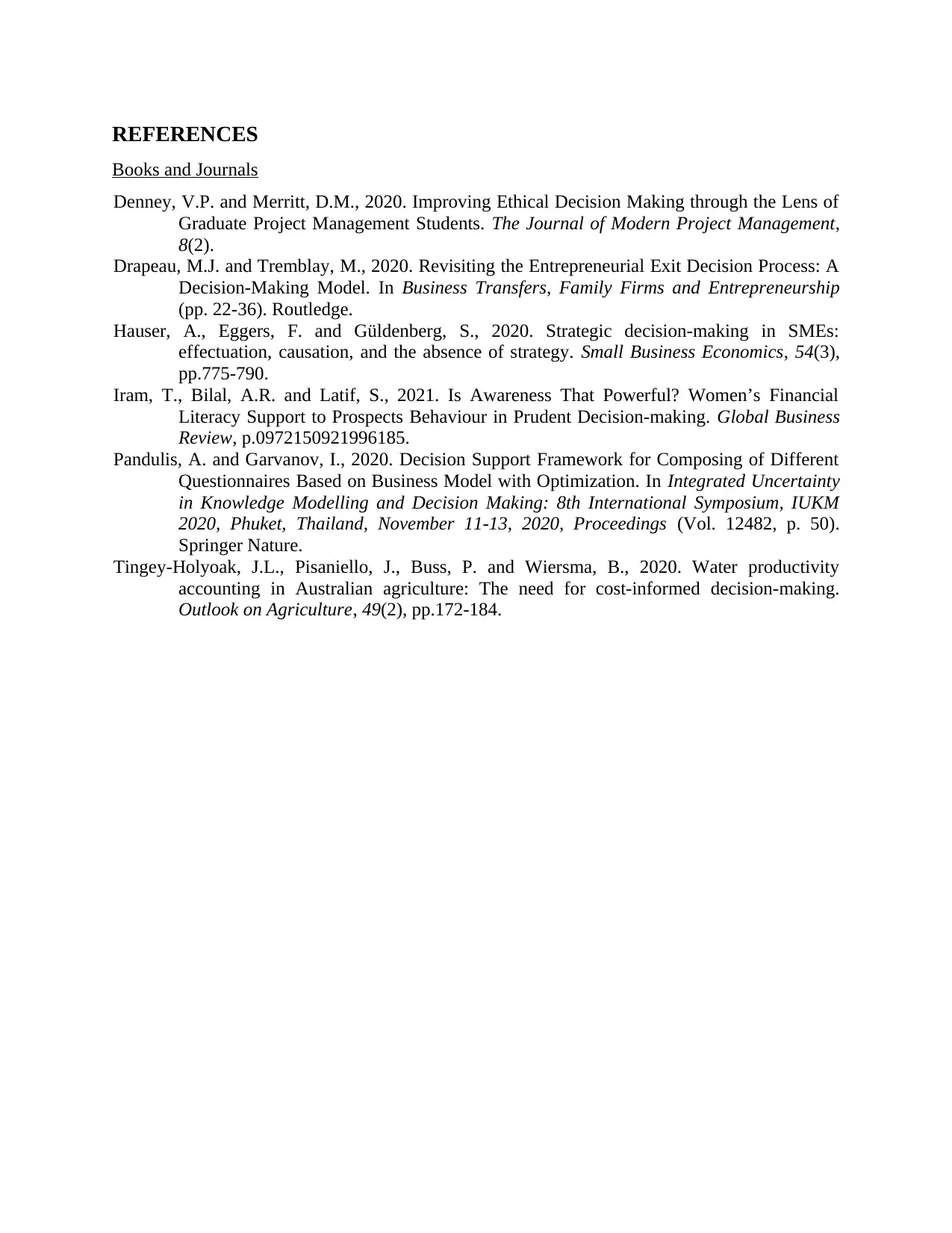
REFERENCES
Books and Journals
Denney, V.P. and Merritt, D.M., 2020. Improving Ethical Decision Making through the Lens of
Graduate Project Management Students. The Journal of Modern Project Management,
8(2).
Drapeau, M.J. and Tremblay, M., 2020. Revisiting the Entrepreneurial Exit Decision Process: A
Decision-Making Model. In Business Transfers, Family Firms and Entrepreneurship
(pp. 22-36). Routledge.
Hauser, A., Eggers, F. and Güldenberg, S., 2020. Strategic decision-making in SMEs:
effectuation, causation, and the absence of strategy. Small Business Economics, 54(3),
pp.775-790.
Iram, T., Bilal, A.R. and Latif, S., 2021. Is Awareness That Powerful? Women’s Financial
Literacy Support to Prospects Behaviour in Prudent Decision-making. Global Business
Review, p.0972150921996185.
Pandulis, A. and Garvanov, I., 2020. Decision Support Framework for Composing of Different
Questionnaires Based on Business Model with Optimization. In Integrated Uncertainty
in Knowledge Modelling and Decision Making: 8th International Symposium, IUKM
2020, Phuket, Thailand, November 11-13, 2020, Proceedings (Vol. 12482, p. 50).
Springer Nature.
Tingey-Holyoak, J.L., Pisaniello, J., Buss, P. and Wiersma, B., 2020. Water productivity
accounting in Australian agriculture: The need for cost-informed decision-making.
Outlook on Agriculture, 49(2), pp.172-184.
Books and Journals
Denney, V.P. and Merritt, D.M., 2020. Improving Ethical Decision Making through the Lens of
Graduate Project Management Students. The Journal of Modern Project Management,
8(2).
Drapeau, M.J. and Tremblay, M., 2020. Revisiting the Entrepreneurial Exit Decision Process: A
Decision-Making Model. In Business Transfers, Family Firms and Entrepreneurship
(pp. 22-36). Routledge.
Hauser, A., Eggers, F. and Güldenberg, S., 2020. Strategic decision-making in SMEs:
effectuation, causation, and the absence of strategy. Small Business Economics, 54(3),
pp.775-790.
Iram, T., Bilal, A.R. and Latif, S., 2021. Is Awareness That Powerful? Women’s Financial
Literacy Support to Prospects Behaviour in Prudent Decision-making. Global Business
Review, p.0972150921996185.
Pandulis, A. and Garvanov, I., 2020. Decision Support Framework for Composing of Different
Questionnaires Based on Business Model with Optimization. In Integrated Uncertainty
in Knowledge Modelling and Decision Making: 8th International Symposium, IUKM
2020, Phuket, Thailand, November 11-13, 2020, Proceedings (Vol. 12482, p. 50).
Springer Nature.
Tingey-Holyoak, J.L., Pisaniello, J., Buss, P. and Wiersma, B., 2020. Water productivity
accounting in Australian agriculture: The need for cost-informed decision-making.
Outlook on Agriculture, 49(2), pp.172-184.
1 out of 7
Related Documents
Your All-in-One AI-Powered Toolkit for Academic Success.
+13062052269
info@desklib.com
Available 24*7 on WhatsApp / Email
![[object Object]](/_next/static/media/star-bottom.7253800d.svg)
Unlock your academic potential
© 2024 | Zucol Services PVT LTD | All rights reserved.


